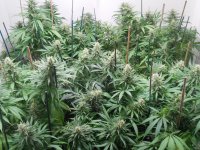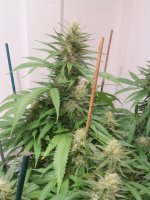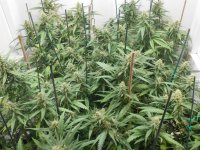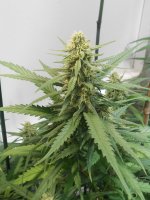moose eater
Well-known member
First 2 pics are of Dronkers' Sensi Seeds California Indica, circa 1997, my 24-year-old keeper, which is about 2 stakes away from being fully restrained. She holds the production record here, which was 22.5 oz. in 4'x4'x6.5' area, under a 400-watt digital HPS.
I no longer do that layout in the boxes, however. THAT was back in the days of augmenting organic soilless mix with FF items and other organic additions, running 16 (lesser) pots per box. No need anymore, and the plants in there, done correctly, can produce pretty close to the original aggregate weights if done properly and thoughtfully.
The next couple pics are of Arjan's Greenhouse Seeds Super Lemon Haze, of which the original is now 20+ years old; perhaps 21 or 22. She's not as productive as some, better than others, unique high, very fuzzy when she's happy, granular resin that feels like coarse brown sugar, and an INCREDIBLE lemon smell to Her.
Both were perpetuated from their original 'keepers' via clone to clone to clone over the years.
---------------------------------------------------
Additional Edit: If my cloudy memory serves me, these are (as of today, and the taking of these pics) about 5 weeks (+/-) into flower.
CI is fairly tight at about 63 to 65 days, providing she doesn't get thrown into a loop as a result of fertilizer or other variables being 'off' too much.
SLH is pretty quick, as well.
-------------------------------------------------
3rd edit: The plants in the images are currently under 315cmh lights (Sun Systems hoods for a bigger footprint than the Hydro-Farm 315cmh hoods, with 4000k Phillips bulbs).
Today I replaced the four LED wet-rated flood bulbs in each box's corners, which are hung in custom-made aluminum hangers in the corners, previously 150-watt equivalent in a 3000k spectrum, with LED wet-rated flood bulbs at the 250-watt equivalent, with 3000k. I still need to upgrade the LED floods bulbs in the corners of two more boxes to get those additions completed.
I no longer do that layout in the boxes, however. THAT was back in the days of augmenting organic soilless mix with FF items and other organic additions, running 16 (lesser) pots per box. No need anymore, and the plants in there, done correctly, can produce pretty close to the original aggregate weights if done properly and thoughtfully.
The next couple pics are of Arjan's Greenhouse Seeds Super Lemon Haze, of which the original is now 20+ years old; perhaps 21 or 22. She's not as productive as some, better than others, unique high, very fuzzy when she's happy, granular resin that feels like coarse brown sugar, and an INCREDIBLE lemon smell to Her.
Both were perpetuated from their original 'keepers' via clone to clone to clone over the years.
---------------------------------------------------
Additional Edit: If my cloudy memory serves me, these are (as of today, and the taking of these pics) about 5 weeks (+/-) into flower.
CI is fairly tight at about 63 to 65 days, providing she doesn't get thrown into a loop as a result of fertilizer or other variables being 'off' too much.
SLH is pretty quick, as well.
-------------------------------------------------
3rd edit: The plants in the images are currently under 315cmh lights (Sun Systems hoods for a bigger footprint than the Hydro-Farm 315cmh hoods, with 4000k Phillips bulbs).
Today I replaced the four LED wet-rated flood bulbs in each box's corners, which are hung in custom-made aluminum hangers in the corners, previously 150-watt equivalent in a 3000k spectrum, with LED wet-rated flood bulbs at the 250-watt equivalent, with 3000k. I still need to upgrade the LED floods bulbs in the corners of two more boxes to get those additions completed.
Attachments
Last edited:















